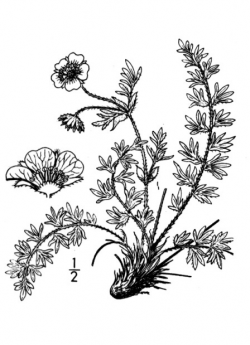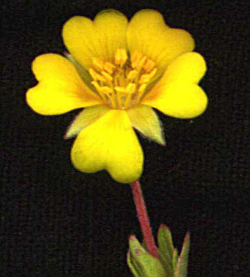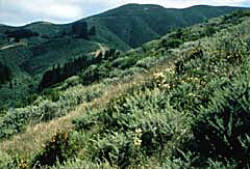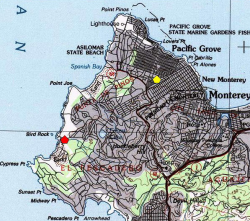
endangered

Illustration from Abrams (1944).

Plant in cultivation from Monterey County © 1997 Tony Morosco.

Photo taken at Montara Mountain, San Mateo County © Mike Vasey.

A red polygon indicates an extant occurrence; yellow indicates that occurrence has been extirpated.



This fact sheet was prepared by Grey F. Hayes and Dean W. Taylor under award NA04N0S4200074 from the National Oceanic and Atmospheric Administration (NOAA), U.S. Department of Commerce (DOC). The statements, findings, conclusions, and recommendations are those of the authors and do not necessarily reflect the views of the NOAA or the DOC.
© Copyright 2006, Elkhorn Slough Coastal Training Program
Last updated: Mar 6, 2015 14:23
Common Names - Hickman's cinquefoil
Family - Rosaceae (Rose Family)
State Status - state endangered
(September 1979)
Federal Status - federal endangered
(August 1998)
Habitat
Vernally wet swales and winter-saturated, heavy soils set in coastal prairie, openings, and meadows in Monterey pine (Pinus radiata) forest; < 100 m.
Key Characteristics
Rosette-forming, long-lived perennial herb from thick taproot, nonglandular, stem prostrate to decumbent, 5–25 cm, ± glabrous; leaves pinnate, petiole generally < blade; basal lvs 3–17 cm, leaflets 6–12, wedge-shaped, 5–20 mm, evenly 2–5-toothed generally 1/2–2/3 to midvein, subglabrous; inflorescence 2–5-flowered, pedicels generally recurved in fruit; petals 6–12 mm, yellow; styles 2–3.5 mm, slender; ovules 10 (Ertter 2013). Plants can reproduce vegetatively by sending out runners (USFWS 2009).
Flowering Period
April to August
Reference Populations
Indian Village, Pebble Beach (Monterey County); Rancho Corral de Tierra, Golden Gate National Recreation Area (San Mateo County).
Global Distribution
Endemic to coastal central California in Monterey and San Mateo counties.
Conservation
Historically, the species was known from the Monterey Peninsula, Monterey County and the area around Half Moon Bay in San Mateo County (USFWS 2009). It is currently known from fewer than 5 occurrences (CNPS 2010). The area where the type specimen was collected in 1902 (Pacific Grove near the reservoir, Monterey County) has never been relocated and is possibly extirpated. The sole remaining native population in Monterey County at Indian Village supports less than two dozen plants and suffers from a variety of threats; it has hovered near extirpation for the last 25 years (approximately 10 individuals were seen in 2008), despite attempts at outplanting (USFWS 2009, Doak et al. 2008). Another outplanting has been attempted at Point Lobos State Reserve. It is not known if that population remains viable (USFWS 2009).
Two San Mateo County colonies from Moss Beach were known from collections (1905, 1933), but these locations were extirpated by development in the 1970s (USFWS 2009). A second San Mateo County population (divided into two occurrences by CNDDB) consisting of approximately six colonies was discovered in 1995 on Montara Mountain by biologists who were conducting surveys for the Devil’s Slide Highway project. As of 2008, this occurrence contained over 3,000 plants (CNDDB 2015). Numbers appear to fluctuate year to year depending on conditions (N. Kramer, pers. comm). Collections from Sonoma County are referable to P. uliginosa (CNPS 2010).
References
Abrams, L. R. 1944. Illustrated Flora of the Pacific States, Vol. 2. Stanford University Press, Palo Alto, CA.
California Natural Diversity Database (CNDDB). 2015. California Department of Fish and Wildlife RareFind 5. http://www.dfg.ca.gov/biogeodata/cnddb/mapsanddata.asp [accessed 27 February 2015]
CNPS, Rare Plant Program. 2010. Potentilla hickmanii, in Inventory of Rare and Endangered Plants (online edition, v8-02). California Native Plant Society, Sacramento, CA. http://www.rareplants.cnps.org/detail/1245.html [accessed 27 February 2015].
Doak, D., M. Goldman, and S. Langridge. 2008. Propagation and Establishment of a New Population of Potentilla hickmanii, Final Report. Prepared for U.S. Fish and Wildlife Service, Ventura Fish and Wildlife Office, Ventura, California.
Ertter, B. 1993. The puzzling Potentillas. Fremontia 21(1):25–29.
Ertter, B. 2013. Potentilla, in Jepson Flora Project (eds.). Jepson eFlora, http://ucjeps.berkeley.edu/cgi-bin/get_IJM.pl?tid=39735 [accessed 27 February 2015].
Kramer, N. Personal communication [28 February 2015].
U.S. Fish and Wildlife Service. 2009. Potentilla hickmanii (Hickman's potentilla) 5-Year Review: Summary and Evaluation. Ventura Fish and Wildlife Office, Ventura, CA. http://ecos.fws.gov/docs/five_year_review/doc2386.pdf [accessed 27 February 2015].
